ML Aggarwal Triangles Exe-10.4 ICSE Class 9 Maths Solutions Ch-10. Step by Step Answer of Exercise-10.4 of Triangles of ML Aggarwal for ICSE Class 9th Mathematics Questions. Visit official website CISCE for detail information about ICSE Board Class-9.
ML Aggarwal Triangles Exe-10.4 ICSE Class 9 Maths Solutions
| Board | ICSE |
| Subject | Maths |
| Class | 9th |
| Chapter-10 | Triangles |
| Topics | Solution of Exe-10.4 Questions |
| Academic Session | 2024-2025 |
Solution of Exe-10.4 Questions
ML Aggarwal Triangles Exe-10.4 ICSE Class 9 Maths Solutions Ch-10
Question 1. In ∆PQR, ∠P = 70° and ∠R = 30°. Which side of this triangle is longest? Give reason for your answer.
Answer : In ∆PQR, ∠P = 70o, ∠R = 30o
But ∠P + ∠Q + ∠R = 180o
⇒ 100o + ∠Q = 180o
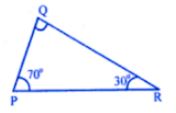
⇒ ∠Q = 180o – 100o = 180o
⇒ ∠Q = 80o the greatest angle
Its opposite side PR is the longest side
Question 2. Show that in a right angled triangle, the hypotenuse is the longest side.
Answer : in right angled ∆ABC, ∠B = 90o
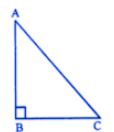
To prove: AC is the longest side
Proof: in ∆ABC,
∠B = 90o
∠A and ∠C are acute angles
That is less then 90o
∠B is the greatest angle
Or ∠B> ∠C and ∠B> ∠A
AC > AB and AC > BC
Hence AC is the longest side
Question 3. PQR is a right angle triangle at Q and PQ : QR = 3:2. Which is the least angle.
Answer :
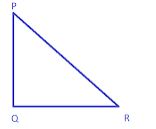
Here, PQR is a right angle triangle at Q. Also given that
PQ : QR = 3:2
Let PQ = 3x, then, QR = 2x
It is clear that QR is the least side,
Then, we know that the least angle has least side
Opposite to it.
Therefore, ∠P is the least angle
Question 4. In ∆ ABC, AB = 8 cm, BC = 5.6 cm and CA = 6.5 cm. Which is
(i) the greatest angle ?
(ii) the smallest angle ?
Answer :
Given that,
AB = 8 cm, BC = 5.6 cm, CA = 6.5 cm.
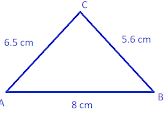
Here, AB is the greatest side. (The greatest side has greatest angle opposite to it)
Then ∠C is the least angle.
Also, BC is the least side.
Then ∠A is the least angle.
Question 5. In ∆ABC, ∠A = 50°, ∠B= 60°, Arrange the sides of the triangle in ascending order
Answer :
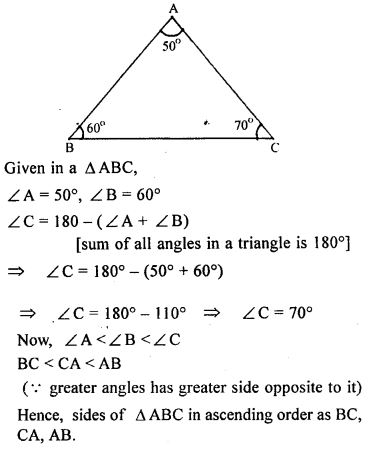
Question 6. In figure given alongside, ∠B = 30°, ∠C = 40° and the bisector of ∠A meets BC at D. Show
(i) BD > AD
(ii) DC > AD
(iii) AC > DC
(iv) AB > BD
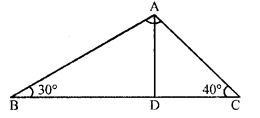
Answer :
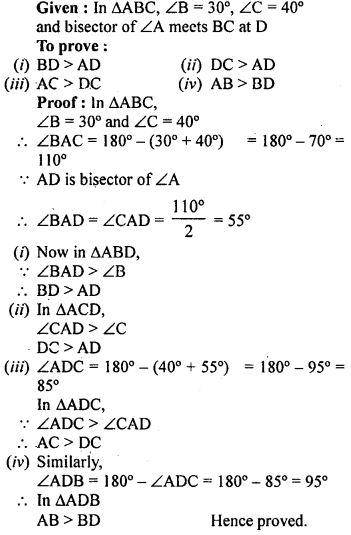
Question 7. In the figure (1) given below, AD bisects ∠A. Arrange AB, BD and DC in the descending order of their lengths.
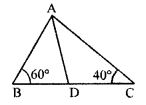
Answer : △ ABC, AD bisects ∠A,
In △ABC,
Sum of angles = 180
∠A + ∠B + ∠C = 180
∠A + 60 + 40 = 180
∠A = 80º
∠BAD = ∠DAC = 40º
∠A = 80º, ∠C = 40º
Since, ∠A > ∠C
BC > AB (Sides opposite greater angles is greater) (1)
In △ADC
∠ACD = ∠DAC = 40º
Thus, AD=DC (Isosceles triangle property)
Now, In △ABD
Sum of angles = 180
∠ABD + ∠ADB + ∠BAD = 180
60 + ∠ADB + 40 = 180
∠ADB = 80º
∠ABD = 60º and △ADB = 80º
Since, ∠ABD > ∠ADB
Thus, AD > AB
or DC > AB (Since, AD = DC) (2)
and we know BC = BD + DC
Hence, BC > DC (3)
Hence, from (1), (2) and (3)
BC > DC > AB
Question 8. (a) In the figure (1) given below, prove that (i) CF> AF (ii) DC>DF.
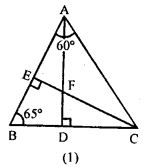
(b) In the figure (2) given below, AB = AC.
Prove that AB > CD.
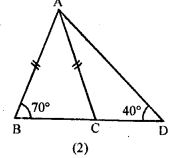
(c) In the figure (3) given below, AC = CD. Prove that BC < CD.
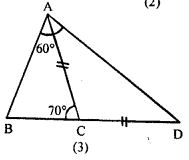
Answer : (a) (i) In triangle ABC
ACB=180-60-65=55
In triangle BEC
BCE=180-90-65=25
SO, ACE=55-25=30
Angle opposite CF=90
Angle opposite AF=30
Hence CF>AF as angle opp CF is greater than the angle opposite AF
(ii) In triangle DFC
DFC= 180-90-DCF ( DCF=25)
DFC=180-90-25=65
Angle opposite DC=65
Angle opp DF= 25
Hence, DC>DF for the same reason as in the first part
(b) Update soon
Question 9. (a) In the figure (i) given below, ∠B < ∠A and ∠C < ∠D. Show that AD < BC.
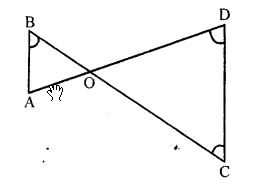
(b) In the figure (ii) given below, D is any point on the side BC of ∆ABC. If AB > AC, show that AB > AD.
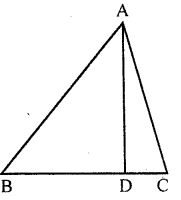
Answer : (a) In figure, ∠B < ∠A and ∠C < ∠D.
To Prove: AD < BC
Proof: ∠B < ∠A | Given
∴ ∠A > ∠B
∴ OB > OA …(1)
| Side opposite to greater angle is longer
∠C < ∠D | Given
∴ ∠D > ∠C
∴ OC > OD …(2)
| Side opposite to greater angle is longer
From (1) and (2), we get
OB + OC > OA + OD
⇒ BC > AD
⇒ AD < BC.
(b) AB > AC We know that,
The angle opposite to greater side is greater than the other……….
Means, ang. ACB > ang. ABC.
NOW, angle ADB = angle ACB + angle DAC
ADB > ang. ABC
OR, AB> AD......
Because, AB is opposite side of angle ADB which is greater than ang. ABC.
Question 10.
(i) Is it possible to construct a triangle with lengths of its sides as 4 cm, 3 cm and 7 cm? Give reason for your answer,
(ii) Is it possible to construct a triangle with lengths of its sides as 9 cm, 7 cm and 17 cm? Give reason for your answer.
(iii) Is it possible to construct a triangle with lengths of its sides as 8 cm, 7 cm and 4 cm? Give reason for your answer.
Answer: (i) Length of sides of a triangle are 4 cm, 3 cm and 7 cm
We know that sum of any two sides of a triangle is greatar than its third side But 4 + 3 = 7 cm
Which is not possible
Hence to construction of a triangle with sides 4 cm, 3 cm and 7 cm is not possible.
(ii) Length of sides of a triangle are 9 cm, 7 cm and 17 cm
We know that sum of any two sides of a triangle is greater than its third side Now 9 + 7 = 16 < 17 ∴ It is not possible to construct a triangle with these sides.
(iii) Length of sides of a triangle are 8 cm, 7 cm and 4 cm We know that sum of any two sides of a triangle is greater than its third side Now 7 + 4 = 11 > 8
Yes, It is possible to construct a triangle with these sides.
— : End of ML Aggarwal Triangles Exe-10.4 Class 9 ICSE Maths Solutions :–
Return to :- ML Aggarawal Maths Solutions for ICSE Class-9
Thanks
Please Share with Your Friends
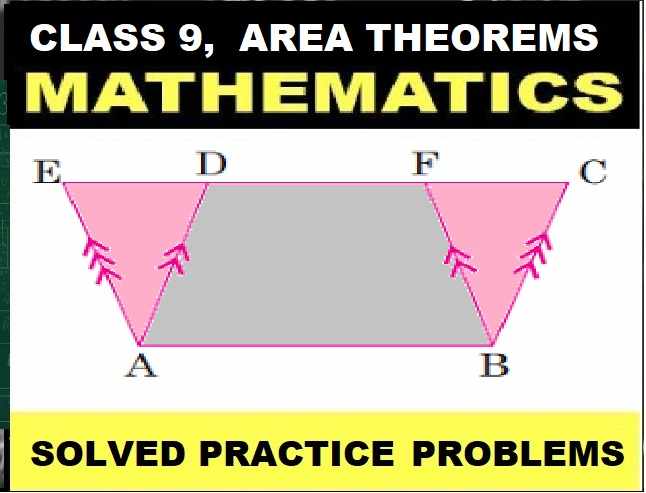


In question 7 you have proved the wrong sides